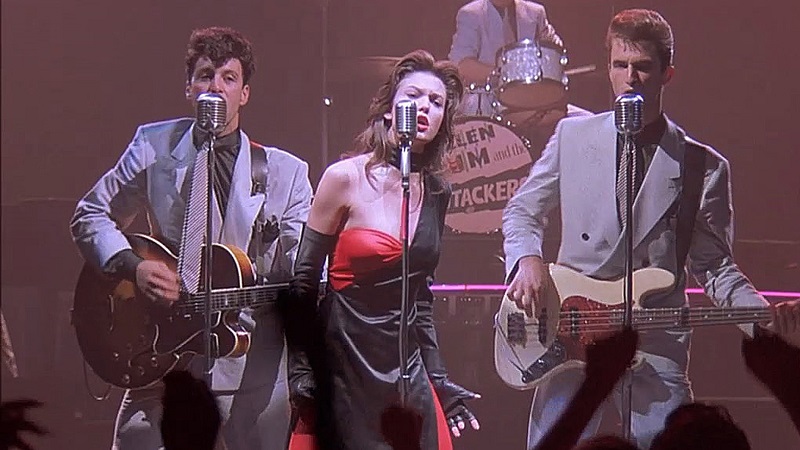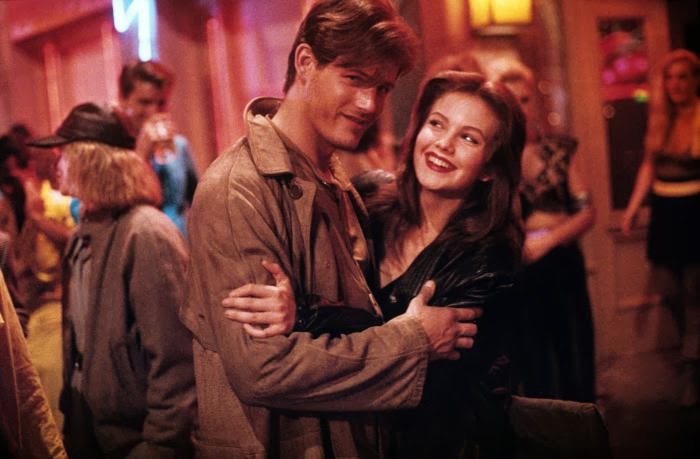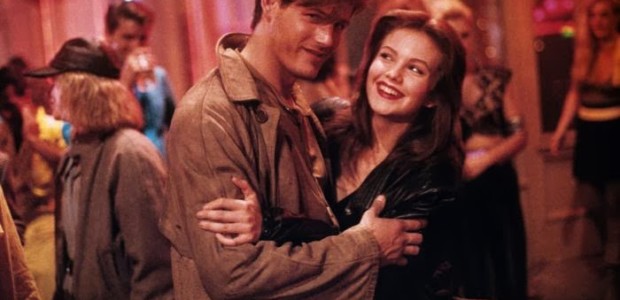DAILY GRINDHOUSE is sponsoring a 70mm screening of Walter Hill’s rock and roll fable, STREETS OF FIRE this Friday and Saturday at Chicago’s Music Box Theatre. We’ll be celebrating this cult classic all week along.
STREETS OF FIRE is a cult classic, as adored by its fans in other countries as it is by those here in America. (Seriously, this movie has a massive Japanese fan-base.) Getting to the point of appreciation was a long road, though. The movie was a major flop upon its June 1, 1984 release, getting walloped not only by STAR TREK III: THE SEARCH FOR SPOCK and INDIANA JONES AND THE TEMPLE OF DOOM, but also by the fifth weekend of the breakdancing epic BREAKIN’. After less than a month on theater screens, it limped away with a meager $8 million gross.
Initially, Universal Pictures thought the project was a sure thing. It was directed and co-written by Walter Hill, whose track record of hits included THE WARRIORS and 48 HRS. Moreover, it seemed on the surface like the right movie at the right time. MTV had taken the country by storm, with music videos beginning to influence the visual style of motion pictures. Here was a film that incorporated a ton of original songs and was intended to be shot in a glossy, stylish manner. How could it lose?
What the studio perhaps didn’t remember is that Hill is an idiosyncratic filmmaker known more for hard-edged, violent movies than musicals (or, as he called STREETS OF FIRE, rock-and-roll fables). When they saw the finished product, cold feet set in. Universal opened it with minimal advertising, meaning that many in the public either didn’t know it existed or didn’t really know what it was about. Worse, they relegated the movie to the B-track theaters – secondary cinemas in the cities and towns where it played. Failing to secure the better venues in higher-trafficked locations certainly didn’t help matters.

So why did this semi-obscure bomb go on to achieve cult status? The short answer is that it was simply ahead of its time. The long answer is…well, there are several key factors.
Fortunately, home video kept STREETS OF FIRE alive long enough for the right audience to discover it. VHS, endless cable TV airings, and DVD exposed it to new eyes over the years. That proved crucial because of the story’s period ambiguity. Hill infused his movie with imagery and settings that were inspired by the 1940s and 1950s, even though it was ostensibly set somewhere close to the modern day. That didn’t seem as cool in the ’80s, a largely forward-looking era where “futuristic” was more popular than “retro” in pop culture. Seen today, such decade-mixing helps give the film a timeless feel that’s enticing.

The music comes off better now, as well. Part of the reason why the MTV-obsessed crowd probably didn’t cling to the movie is that the songs weren’t entirely in touch with what was going on at that point in time. Whereas America was enthralled with the cutting-edge sounds of Duran Duran, Culture Club, and Prince, STREETS OF FIRE had several songs written by Jim Steinman that were reminiscent of the tunes he wrote for Meat Loaf in the 1970s and Bonnie Tyler in the early ’80s. They were just a beat behind the times.
Other songs were performed by the rockabilly band The Blasters. Again, not the most contemporary of artists. Only Dan Hartman’s “I Can Dream About You” became a radio hit, but its old-school soulfulness was akin to the things Daryl Hall and John Oates were scoring with at the time, making it easier to gain airplay. The sole concession to true ’80s music was the use of “Deeper and Deeper” by The Fixx over the end credits – a great song that still sounds out of place with everything else. More than thirty years later, the hybrid of musical styles reveals itself to be a fascinating stylistic choice that helps define both the characters and the settings.

Perhaps one of the biggest reasons why STREETS OF FIRE plays better now than it did then is the nature of the performances. Diane Lane was, like her character, an up-and-comer in 1984. Today we know her as an acclaimed actress. Going back and seeing her as Ellen Aim emphasizes the amazing degree to which Lane filled the character with a palpable, possibly bordering on autobiographical, hunger for success. The villain of the piece, Raven Shaddock, was played by a young Willem Dafoe. He wasn’t a draw at the time. Now he’s an actor known for the intensity he brings to his roles. It’s what people love him for. One can most definitely appreciate seeing him do this early on, establishing what would become a recurring motif in his career. And Michael Pare, as the enigmatic Tom Cody, seems extra mysterious in the part. His career never quite took off the way many assumed it would after his breakthrough in EDDIE AND THE CRUISERS, yet he’s always been around, working in this or that. He seems perfect for the role of the fringe-dwelling Tom in retrospect.
In ’84, audiences probably would have liked a more mainstream, conventional movie that hewed closer to what was going on culturally. Had Hill gone that route, STREETS OF FIRE might still be enjoyable, but it would definitely be dated. Instead, we can look back on it after three decades and see what was easily missed back then – that this is a bold, ambitious, non-conformist picture unafraid of forging its own path. Although many great movies came out of the ’80s, a lot of them followed the “rules” of the day. This one doesn’t, and that makes it a film that can be continually re-appreciated by existing fans and discovered by newcomers.
—MIKE MCGRANAGHAN
- [DINOSAUR WEEK!] A SOUND OF THUNDER (2005) - June 12, 2015
Tags: Amy Madigan, Dan Hartman, Diane Lane, Ellen Aim & The Attackers, Jim Steinman, Michael Paré, rick moranis, Streets Of Fire, The Sorels, walter hill



This was a thoughtful and spot on analysis of this movie. Well done. The only thing missing is an honest comment about the obvious struggles they had with the script. They knew it then and it is still lacking. But, it is difficult to not walk away hearing the music in your head and feeling like you enjoyed something meant just for you. Weird but quite original.